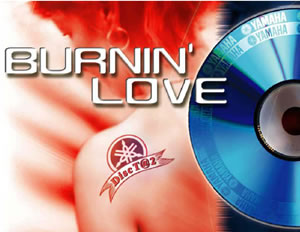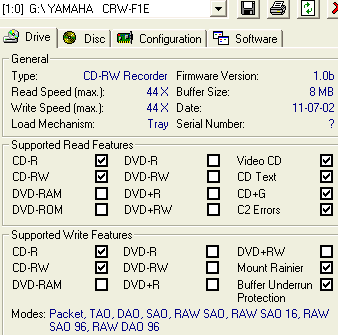YAMAHA CRW-F1E CD-RW
1. Introduction
YAMAHA CRW-F1E IDE CDR-W - Page 1
- Introduction
 When
YAMAHA announced the new CRWF1 recorder everybody was impressed and really curious
whether the drive would be faster and more reliable from the compatible P-CAV
48X recorders. The questions that come up are also focused upon not only the
recording times maintained but upon the produced writing quality, the supported
media list and the price, as well. We cannot hide our anxiety to test this drive
and to compare it with the current leaders in this recording race from Asus,
CyberDrive, LiteOn and others.
When
YAMAHA announced the new CRWF1 recorder everybody was impressed and really curious
whether the drive would be faster and more reliable from the compatible P-CAV
48X recorders. The questions that come up are also focused upon not only the
recording times maintained but upon the produced writing quality, the supported
media list and the price, as well. We cannot hide our anxiety to test this drive
and to compare it with the current leaders in this recording race from Asus,
CyberDrive, LiteOn and others.
- Full CAV Recording Technology
![]() YAMAHA
CRW-F1 uses full CAV recording/reading technology, which means that a constant
rotation speed is maintained from the beginning of the recording process, from
the inner tracks of the disc, all the way to the tracks at the outer edge.
YAMAHA
CRW-F1 uses full CAV recording/reading technology, which means that a constant
rotation speed is maintained from the beginning of the recording process, from
the inner tracks of the disc, all the way to the tracks at the outer edge.
 By
eliminating fluctuation in the rotation speed during the recording process,
YAMAHA claims that effectively removes the biggest cause of the writing errors
that lead to unreadable media. The spindle motor of the CD-R unit maintains
a constant disc rotation speed of 8700 rpm throughout the entire writing process,
while the actual writing speed smoothly increases from 19X to 44X.
By
eliminating fluctuation in the rotation speed during the recording process,
YAMAHA claims that effectively removes the biggest cause of the writing errors
that lead to unreadable media. The spindle motor of the CD-R unit maintains
a constant disc rotation speed of 8700 rpm throughout the entire writing process,
while the actual writing speed smoothly increases from 19X to 44X.
The left chart shows how writing speed on the CRW-F1 accelerates during a burn. It begins at 19X and then smoothly accelerates to 44X in the outermost area. Its spindle motor speed is completely maintained at 8700 RPM while it increases its writing speed. Also very important: there are no "shift-up" links (since the motor does not need to hastily speed up to the next step).
YAMAHA also developed a new technology, to offer more writing stability to the CRW-F1E. The "Dynamic Damper Mechanism" reduces vibration and noise, allowing smooth acceleration and rotation at ultra fast rotation speeds of 8500-9000 rpm.

The virtual "heart" of the CRW-F1 is the newly developed LSI of the drive, the "YDC132-V". It enables high-quality and high speed writing by meticulously controlling all the features of the drive, including:
- Digital optical laser power control
- Disc rotation and acceleration
- Full CAV writing strategy
- DiscT@2
- Advanced Audio Master Quality Recording
Below is a diagram that re-presents the internal YAMAHA F1 structure:

 is
an original YAMAHA-only feature that allows text and images to be drawn on the
unused portion of a CD-R disc. You can now etch a memo, your signature, photo
thumbnails or your company's logo right onto the bottom of the disc. The CRW-F1
is the first drive to offer the DiscT@2 Laser labelling system.
is
an original YAMAHA-only feature that allows text and images to be drawn on the
unused portion of a CD-R disc. You can now etch a memo, your signature, photo
thumbnails or your company's logo right onto the bottom of the disc. The CRW-F1
is the first drive to offer the DiscT@2 Laser labelling system.
 As
YAMAHA says "...Over a decade of research has been invested in achieving
the ultimate in recording accuracy-and it is this accuracy which is employed
in the DiscT@2 process. Drawing visible designs on a disc is no easy task.
As
YAMAHA says "...Over a decade of research has been invested in achieving
the ultimate in recording accuracy-and it is this accuracy which is employed
in the DiscT@2 process. Drawing visible designs on a disc is no easy task.
This feature is made possible through YAMAHA's industry-leading control of the elements of recording: 1) tracking; 2) rotation; 3) laser intensity and positioning. DiscT@2 is an expression of YAMAHA innovation, showcasing its leadership in CD-R/RW technology..."
Usually a recording application will supply a CD recorder with raw digital data, to which the recorder's hardware adds header and error correction information, and then converts it to what is known as EFM (Eight-to-Fourteen-Modulation) patterns. These are the little chunks of data that get written to disc.
Usual EFM Recording Patterns

EFM patterns for CD-R writing vary from a minimum of 3T (0.83 micrometres at a linear velocity of 1.2 m/s) to a maximum of 11T (3.05 micrometres at a linear velocity of 1.2 m/s). A combination of patterns, from 3T to 11T, is used for writing to CD-R. The result (other than storing your valuable data, of course) is that the burned area looks darker than the unused area. DiscT@2 takes things further and breaks free from the limitations imposed by normal EFM patterns. This allows for more flexibility in how the laser burns to CD-R, making the drawing of visible images possible.
Visible Images Using DiscT@2 Patterns

After the writing stage is completed you can fill the remaining outer space of the disc with text and data such as the names of the songs or files on the disc, personal signatures or company logos, creation dates (i.e. when making backups of hard drives).

YAMAHA CRW-F1 also sets the new standard for CD-RW Rewriting at 24x. The "Ultra Speed" Full CAV mode offers 24x rewriting for random access packet data rewriting, while Partial CAV mode does the same for conventional data rewriting.
Another useful feature of the new YAMAHA drive is the "CD-RW Audio Track Edit". The application allows users to change the track order or erase a track on a CD-RW with audio files. You can edit the recorded audio files directly on the CD-RW without the need to move them on your hard disk first. This feature is similar to the editing process you possibly do on your Minidisk.
Of course, YAMAHA includes the already known AudioMASTER Quality Recording feature, which now supports 1X and 8X writing speeds as well as the original 4X speed mode. You can select the proper writing speed for the media in use, or use the "Best" mode allowing the CRW-F1 to determine the best writing speed.
Nero info tool reports that the drive supports 44X reading and writing, the firmware installed is the v1.0b and buffer underrun protection is available. The "SafeBurn" features an 8MB memory buffer, buffer underrun protection and Optimum Write Speed Control.

The drive also supports the following writing modes: Track-at-Once, Disc-at-Once, Session-at-Once, Multisession, packet writing and Mount Rainier. The exact supported writing speeds are: 1X, 4X, 8X, 16X, (CLV) and 44X, Full CAV. The rewriting speeds are:













